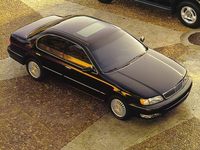New Car Review
SEE ALSO: Infiniti Buyer's Guide
1998 INFINITI I30
by Tom Hagin
SPECIFICATIONS Manufacturer's Suggested Retail Price $ 28,900 Price As Tested $ 30,695 Engine Type DOHC 4-valve 3.0 Liter V6 w/SMFI* Engine Size 181 cid/2988 cc Horsepower 190 @ 5600 RPM Torque (lb-ft) 205 @ 4000 RPM Wheelbase/Width/Length 106.3"/69.7"/189.6" Transmission Four-speed automatic Curb Weight 3174 pounds Fuel Capacity 18.5 gallons Tires (F/R) P205/65R15 Brakes (F/R) Disc (ABS)/disc (ABS) Drive Train Front-engine/front-wheel-drive Vehicle Type Five-passenger/four-door Domestic Content N/A Coefficient of Drag (Cd.) 0.32 PERFORMANCE EPA Economy, miles per gallon city/highway/average 21/28/25 0-60 MPH 7.0 seconds 1/4 Mile (E.T.) 16 seconds @ 91 mph Top speed 123 mph * Sequential multi-point fuel injection
Car makers constantly look for ways to fill "hot" market segments, and since those segments appear quickly, timing is very important. Over the last few years, the hottest sedan segment is the under-$30,000 mid-luxury class. So for Infiniti to participate, things were simple: take the outstanding new Maxima from its parent company Nissan, dress it up more formally, then coddle its buyers in sparkling showrooms.
The I30 was introduced to fill the gap between Infiniti's since-departed entry-level G20 and the pricey rear-wheel-drive J30. There are two I30 models: the top-line Touring, and the I30 Standard.
OUTSIDE - We lined the '98 I30 up next to an original 1996 model and found the two nearly identical. We then lined it up next to a '98 Maxima and found the roof line and doors to be the same, but the overall look different. This year brings new headlamps to the I30 with the trendy "jeweled" effect, and a new tail lamp cluster similar to that used on the most expensive Infiniti of the three-model line, the Q45. The finely detailed formal grille is a noticeable departure from the Nissan norm, while the tail is clean and nicely squared. Trunk space is voluminous at over 14 cubic feet, and its opening is wide with a low lift-over. A handy pass-through opening in the rear seat's center armrest allows the transporting of long items, but the seat itself doesn't fold. Our test model, called the Standard by Infiniti, comes equipped with 15-inch aluminum wheels and all-season 205/65 tires.
INSIDE - I30 has one of the most spacious interiors in its group. It's classified as a midsized car by the EPA, unlike many of its direct competitors, and can easily haul five adults comfortably. Both I30 models come with wide bucket seats up front, covered in either cloth upholstery, or new perforated leather. The center console has been revised for 1998, as have the climate controls and cupholders. Our test model had lots of standard features which included power seats, outside mirrors, windows and door locks, a 200-watt AM/FM/CD/cassette system, cruise control and variable speed intermittent wipers. Infiniti's optional Leather and Convenience package adds leather upholstery, a power sunroof, automatic day-night inside rearview mirror, and a Homelink transmitter in the driver's sunvisor.
ON THE ROAD - The I30 also shares its powertrain with the Maxima. Both were introduced using a new 3.0 liter V6 engine with twin cams and four valves per cylinder. It produces 190 smooth horsepower and 205 lb-ft of torque. With a 0-60 mph time of seven seconds, it is one of the quickest sedans in the near-luxury class. Power is delivered to the front wheels over a wide rpm range, and becomes available at almost any speed. Transmission choices aren't usually offered in this class, but the I30 is available with either a standard equipment five-speed manual transmission, or an electronically-controlled four-speed automatic. We drove I30s with both, and the five-speed was by far the sportier of the pair. A viscous limited-slip differential is optionally available with the standard model and a no-charge item with the I30 Touring.
BEHIND THE WHEEL - Underneath the I30 is an independent front suspension with MacPherson struts, coil springs and a thick anti-roll bar. The rear setup uses a beam axle with multi-links and coil springs, and an even thicker anti-roll bar. Our standard model's suspension was tuned for a smooth comfortable ride, made to soak up potholes and broken pavement with ease. The I30 is packed with more insulation than its sister, the Maxima, so even those corduroy-surfaced segmented freeways didn't allow much noise inside. Its steering is quick and powerful, and uses speed-sensitive boosting to give more road feel at highway speeds. The braking system is top-notch: four-wheel discs with anti-lock (ABS), which gave us steady stops at many different speeds. Fading became apparent after repeated high-speed stops, but exhibited virtually no front end dive in panic stop situations.
SAFETY - Two airbags are in the dash, and two more are sewn into the front seats. Side-impact crush protection and ABS are also standard.
OPTIONS - The Leather and Convenience package adds $1300.



